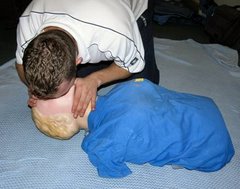Shock
Casualties who have lost fluid from the body are particularly prone to shock - those suffering bleeding, burns, vomiting, diarrhoea and abdominal injuries.
Signs of shock:
Initially:
- Rapid pulse.
- Pale, cold and clammy skin.
- Sweating.
- Grey-blue skin.
- Weakness and gidiness.
- Nausea or thirst.
- Rapid, shallow breathing.
- Weak pulse.
- Restlessness.
- Gasping for air.
- Unconsciousness.
- Lay the casualty down. Lie the casualty down on soft ground, ideally a blanket and raise their legs.
- Loosen tight clothing.
- Get help.
- Monitor the casualty's responsiveness, airway and breathing. Be prepared to give CPR if the casualty stops breathing.
- Allow the casualty to eat, drink, smoke or move.
- Leave the casualty unattended, other than to go and get help.




